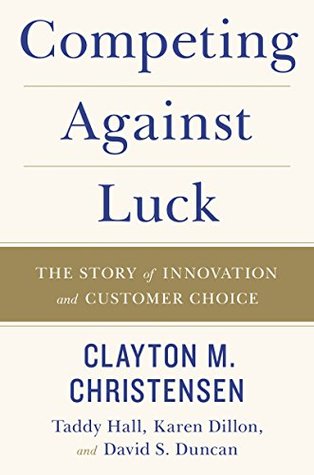More on this book
Community
Kindle Notes & Highlights
seeing jobs in your own life, finding opportunity in “nonconsumption,” identifying workarounds, zoning in on things you don’t want to do, and spotting unusual uses of products.
Innovation is less about producing something new and more about enabl...
This highlight has been truncated due to consecutive passage length restrictions.
important for cu...
This highlight has been truncated due to consecutive passage length restrictions.
But Moesta took a different approach: he set out to learn what job the condominium was hired to do for people who had already bought a unit.
What was stopping buyers from making the decision to move was not something that the construction company had failed to offer, but rather the anxiety that came from giving up something that had profound meaning.
“I went in thinking we were in the business of new home construction,”
seeing jobs in your own life,
finding opportunity in nonconsumption,
identifying work...
This highlight has been truncated due to consecutive passage length restrictions.
zoning in on things we don’t ...
This highlight has been truncated due to consecutive passage length restrictions.
spotting unusual uses of...
This highlight has been truncated due to consecutive passage length restrictions.
you have to look all around it to understand the context of a job before you can innovate to solve it.
“We’d designed a terrific software system that we thought would help this doctor get his job done, but he was choosing to ‘hire’ a piece of paper and pen instead,”
we’d designed everything in that room from a functional perspective, but we had completely overlooked the emotional score.”
You can’t do design requirements in a conference room. You have to get out in the wild and live it.”
When you start with the assumption that you’re just altering what you already have created, or relying on broader industry-accepted
accepted category definitions, you may have already missed the opportunity to uncover the real job for consumers.
So P&G worked to make sure that potential customers would recognize how its diapers truly solved the full Job to Be Done in their lives.
If a consumer doesn’t see his job in your product, it’s already game over. Even worse—if a consumer
hires your product for reasons other than its intended Job to Be Done, you risk alienating that consumer forever.
What they have in common is the search for cause.
develop a deep understanding of the job,
what matters most is
the questions you ask in applying them and how you piece the resulting information together.
If you observe people employing a workaround or “compensating behavior” to get a job done,
It’s usually a clue that you have stumbled on to a high-potential innovation opportunity,
Closely studying how customers use your products often yields important insights into the jobs,
pay equally close attention to uncovering the emotional and social dimensions,
critical to your solution nailing the job.
A genuine insight,
is a thought that is experienced as true on conception.
key to getting hired is to understand the narrative of the customer’s life in such rich detail that you are able to design a solution that far exceeds
anything the customer themselves could have found words to request.
Customers are often unable to articulate what they want;
their actions often tell a completely different story.
Developing a full understanding of the job can be done by assembling a kind of storyboard
As part of your storyboard, it’s critically important to understand the forces that compel change to a new solution,
understand the forces opposing any change,
innovate the experiences you provide in a way that mitigates them,
products succeed not because of the features and functionality they offer but because of the experiences they enable.
American Girl is able to command a premium price because it’s not really selling dolls. It’s selling an experience.
rarely is it the product itself that is the source of the long-term competitive advantage,
creating the right set of experiences around a clearly defined job—and then organizing the company around delivering those experiences
thesis that innovation succeeds when it addresses a job that needs to be done,”
the job itself is the framing of the


